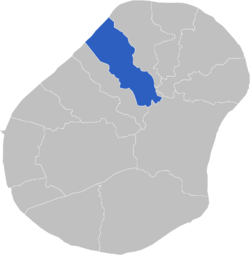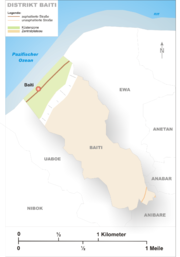- Beidi
-
Baiti
Baiti
(Baitsi/Beidi) Carte de localisation du district de Baiti.
Carte de localisation du district de Baiti.Administration Pays  Nauru
NauruType District Date de création 1968 Géographie Superficie 1,23 km² Altitude maximale 45 m Altitude minimale 0 m Démographie Population 443 hab. (2002[1]) Densité 360,2 hab./km² Baiti, en nauruan Baitsi ou Beidi, est un des quatorze districts de Nauru. Le district de Baiti fait partie de la circonscription électorale d'Ubenide.
Sommaire
Géographie
Baiti se trouve dans le Nord-Ouest de l'île de Nauru. Il est bordé par l'océan Pacifique au nord-ouest et par les districts de Ewa au nord-est, Anabar à l'Est, Anibare au sud-est et Uaboe au sud-ouest.
Son altitude moyenne est de 25 mètres (minimale : 0 mètre, maximale : 45 mètres) et sa superficie est de 1,2 km2 (septième rang sur quatorze).
Population
Baiti est peuplé de 443 habitants (huitième rang sur quatorze) avec une densité de population de 360,2 hab/km2[1]. La zone correspondant au district de Baiti était composée à l'origine de 15 villages : Adrurior, Aeonun, Anakawida, Anut, Ataneu, Atirabu, Baiti, Deradae, Ibedwe, Imangengen, Imaraga, Mangadab, Mereren, Umaruru et Yatabang.
Annexes
Lien externe
Références
- (de) Cet article est partiellement ou en totalité issu d’une traduction de l’article de Wikipédia en allemand intitulé « Baiti (Distrikt) ».
- (en) Cet article est partiellement ou en totalité issu d’une traduction de l’article de Wikipédia en anglais intitulé « List of cities in Nauru ».
- ↑ a et b (en)Nauru bureau of statistics, « Average household size by district, Nauru, 2002 », 2007. Consulté le 16 novembre 2008
- Portail de Nauru
Catégorie : District de Nauru
Wikimedia Foundation. 2010.


